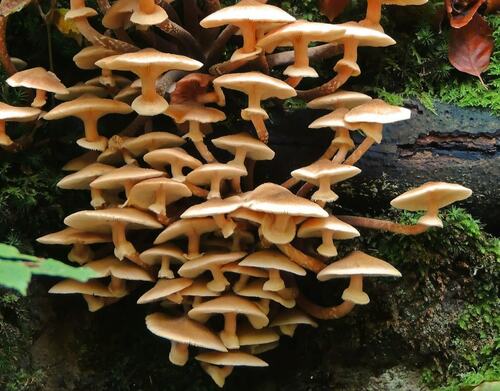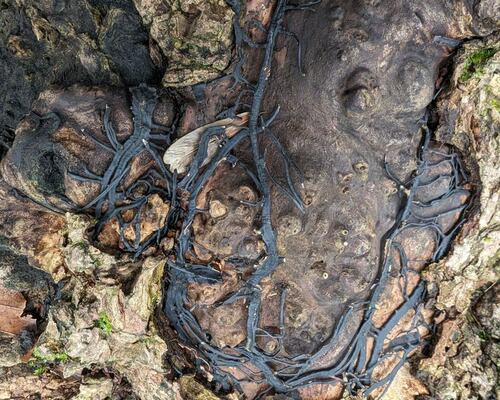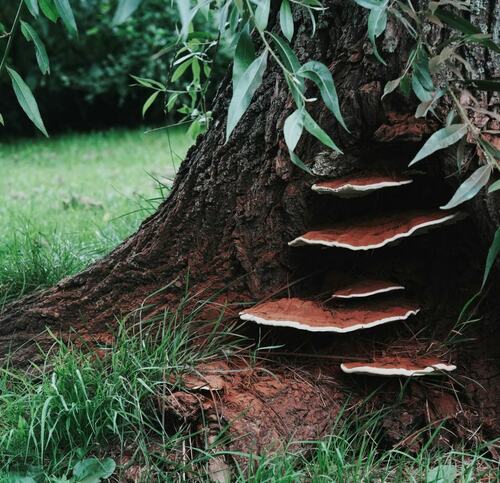Tree Fungi: Friend or Foe? Understanding Their Crucial Roles in Forest Ecosystems
Introduction
When we think of fungi, we often think of them as either dangerous pests or mysterious things that grow in dark, damp places. But fungi play many important roles in nature, especially for trees. Let’s explore the roles and impacts fungi have and if they are friends or foes.
WHAT ARE FUNGI?
Fungi are a group of living things that include yeasts, molds, and mushrooms. Unlike plants, fungi can’t make their own food using sunlight. Instead, they get food by breaking down dead things or by working together with other living things. When it comes to trees, we can sort fungi into different groups based on how they interact with trees and what they do.
The Many Roles of Fungi

Oyster Mushrooms Growing on a Tree Trunk – Photo by Zdeněk Macháček on Unsplash
Fungi that interact with trees can be grouped into three categories: beneficial, neutral, and harmful. Understanding these roles helps us appreciate their complex relationship with trees.
SYMBIOTIC RELATIONSHIPS
One of the most important things fungi do is work with trees for mutual benefit. For example, mycorrhizal fungi work with tree roots to get the nutrients they both need. These fungi help trees absorb more food, water and nutrients from the soil, which helps them grow. In return, the fungi get some of the sugar trees make when absorbing sunlight. This relationship is essential for many species of trees to grow, especially in soil that doesn’t have many nutrients.
There are two main ways mycorrhizal fungi work with tree roots. The first way is called “ectomycorrhizal,” where the fungi wrap around the roots like a blanket and stab into the outer part of the root. The second way is called “endomycorrhizal,” where the fungi go deeper into the root and make structures called “arbuscules” inside. Both types help trees get more food from the soil and handle stress better.
NATURE’S DECOMPOSERS

A Cluster of Mushrooms on a Decaying Log – Photo by Ben Hoftijzer on Unsplash
Fungi are also essential decomposers in forest ecosystems. Saprotrophic fungi break down dead organic matter, including fallen leaves, branches, and dead trees. This decomposition process recycles nutrients back into the soil, making them available for other plants and organisms. Without fungi, forests would be overwhelmed with organic debris, and nutrient cycling would be severely disrupted.
The decomposition process involves various stages, starting with the breakdown of complex organic compounds like cellulose and lignin into simpler molecules. Fungi secrete enzymes that degrade these compounds, enabling them to absorb the resulting nutrients. This process not only recycles nutrients but also contributes to soil formation and structure, promoting overall forest health.
PATHOGENIC FUNGI
Not all fungi are good. Some, called pathogenic fungi, can cause diseases in trees. Pathogenic fungi invade tissues in trees and cause infections that can lead to serious damage or even death. Common tree diseases that are caused by these fungi are Dutch Elm Disease, chestnut blight, and oak wilt. These diseases can spread quickly and can wreck the ecosystem of the forest and of urban landscapes.
Pathogenic fungi often get into trees through cuts or tiny holes. Once they’re inside, they make toxins and enzymes that interrupt the processes of the trees. This can make the tree’s leaves droop, make branches die, or cause sores on the bark. To manage these diseases, you need to spot these problems early so you can use the right practices, and in some cases, use chemical treatments.
WOOD DECAY FUNGI
Wood decay fungi do exactly what their name suggests—they eat away at the lignin and cellulose in wood. While they do play a role in decomposition, this can be dangerous if they infect living trees or wooden structures because it causes the wood to become soft and weak. In living trees, this can make the tree less stable and more likely to be damaged by the wind. These fungi can also cause wooden structures to be more likely to collapse. This can lead to expensive repairs.
Wood decay fungi are grouped into three types based on the kind of decay they cause: white rot, brown rot, and soft rot. White rot fungi eat away at cellulose and lignin. This leaves behind a white, stringy residue. Brown rot fungi mostly break down cellulose. This leaves behind a brown, crumbly residue. Soft rot eats away cellulose in certain places on the tree. This often affects the outer layers of wood.
PARASITIC FUNGI

A Tree Trunk Infected with Armillaria Fungus
Parasitic fungi get the nutrients they need by sucking them out of their host trees. These fungi can cause a range of problems, from minor damage to major health issues. Some examples of this are Armillaria fungi , which can cause the roots of trees to rot, or rust fungi that affect the leaves and stems of trees. Managing parasitic fungi is important to keeping trees healthy.
Parasitic fungi often make special structures that pierce host cells and suck nutrients out of them. This can weaken the host tree, making it more likely to be affected by other things like drought or infestations. These fungi can be dealt with by keeping the tree healthy. Things like giving it the right amount of water, mulching around the tree, and pruning it will deter harmful fungi.
Balancing the Roles of Tree Fungi
Fungi that live on or near trees can be grouped into three categories: beneficial, neutral, or harmful. To manage them, you first need to understand each of the roles of fungi. The best way to manage tree fungi is to help the good ones grow while controlling the bad ones.
PROMOTING BENEFICIAL FUNGI

Mushrooms Growing on the Base of a Tree – Photo by Anya Chernik on Unsplash
We can help mycorrhizal fungi grow by doing things like making sure the soil isn’t packed too tightly, not using too much fertilizer, and adding natural things like compost to the soil. These actions make the soil better for helpful fungi to live in, which helps trees stay healthy and grow better.
MANAGING HARMFUL FUNGI
To control harmful fungi like pathogenic, wood decay, and parasitic fungi, we need to watch the trees closely, take a good care of them, and sometimes use special chemical treatments. Checking trees often helps us find fungal problems early so we can fix them quickly. Taking care of trees properly, including pruning them and keeping them clean, helps prevent fungal infections. If there is a severe case, special treatments like fungicides might be used. These shouldn’t be used too much, though, because they can hurt the environment.
Conclusion
Tree fungi are complex living things that can be both helpful and harmful to trees. Fungi have many roles, like working together with trees to help them grow, to breaking down dead plants, to making trees sick and taking nutrients from them. By learning about all the different roles fungi have in forests, we can better understand how important they are. This knowledge helps us figure out ways to keep trees healthy and strong. If we can manage the good and bad effects of fungi, we can help trees grow well and keep forests healthy for all the plants and animals that live there.
If you suspect that one or more of your trees has a fungal issue, contact Arborist Now immediately. Our certified arborists can accurately identify the issue and implement a treatment plan to keep the disease from spreading and bring your trees back to full health.


